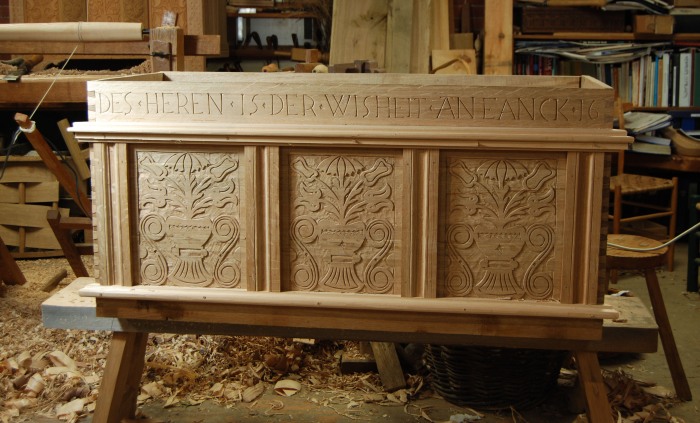There’s slow food, slow train coming, slowhand Clapton – and slow-grown oak. This is a concept I have covered before on the blog, but there’s many new readers these days. I have two sections of oak I’ve been working lately that illustrate the differences between fast-grown and slow-grown oak very well.
On the left above is a piece of red oak that is about 4″ high x 1″ thick. It’s riven radially and planed green. I counted somewhere in the vicinity of 70 years of growth on this one piece.
Next to it is a stile for a joined chest – also red oak, it seems to be about 16 years’ worth of growth there, in 3 1/2″ of stock. Technically, the fast-grown stuff is stronger than the opposite; with fewer years, there’s fewer earlywood open pores. thus a greater concentration of dense material.
The slow-grown stuff has so many bands of early wood, the porous vessels that grow in the springtime; that it is lighter in weight, and has less strength in some aspects than the fast stuff.
when every thing else is equal (straight, no knots, large diameter, etc ) I would much rather use the slow stuff. It works easier, and has a better “grain” than the fast growth.
Here are the same two sticks of wood, the slow one behind, the fast one in front. On the radial face, the slow one’s appearance is much more even, the fast one stripey-looking. When carving them, the fast one is bumpy as you cut across the transitions from early wood to late wood. Bump, bump, bump as you trip across those pores.
Both of these particular sections were very nice-splitting oaks; the fast one surprisingly good. Its radial face was dead-flat and just needed smoothing. But I have relegated it to the rear framing of an oak carved chest underway, because I don’t want to look at it.
I have seen some English furniture of the 17th century that has fast grown oak; but the New England stuff, and the better-quality English stuff is in finer-grained oak.
Here’s a detail view
With 350 years of patina, the stripey look isn’t too jarring, but when new it is distracting to me.
A New England chest, oak framing around a pine panel. pine lid above. But the oak is the slow-grown stuff I have harped about enough now.
Most of these photos should enlarge considerably, so to really see them, skip the phone & other tiny devices. Like the Rolling Stones, these should be played loud – I mean opened up big.










































